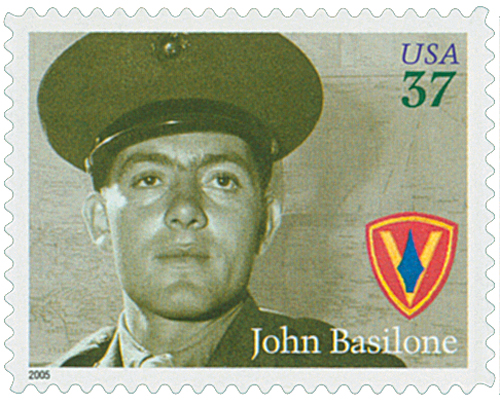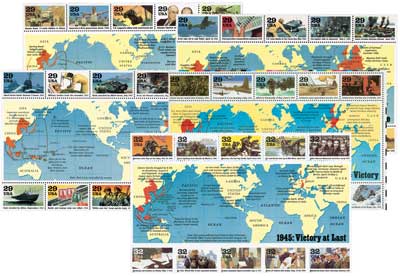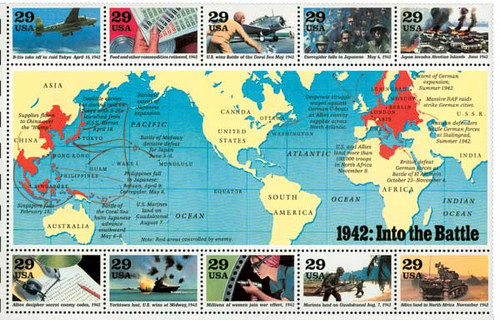
# 2697i FDC - 1992 29c World War II: Marines Land on Guadalcanal
US #2697i
1992 Marines Land on Guadalcanal, August 7, 1942
- Part of the second Souvenir Sheet issued to commemorate 50th anniversary of World War II
- Sheet contains 10 stamps and a world map.
Stamp Category: Commemorative
Set: 1942: Into the Battle, World War II
Value: 29¢ First Class Mail Rate
First Day of Issue: August 17, 1992
First Day City: Indianapolis, Indiana
Quantity Issued: 12,000,000 stamps
Printed by: Bureau of Engraving and Printing
Printing Method: offset/ intaglio
Format: Sheetlets of 10, arranged in two strips of 5 with a world map between. Offset printing plates of 8 sheetlets (2 across, 4 down). Intaglio printing sleeves of 16 sheetlets (2 across, 8 down)
Perforations: 11
Why the stamp was issued: This stamp is part of a sheetlet issued to commemorate the 50th anniversary of World War II. It was the second in a series of five that were issued over the course of five years.
About the stamp design: There were many topics the USPS wanted to cover when commemorating World War II, but those planning the series didn’t want to issue a large number of stamps. It was decided a sheetlet format would best highlight the main events of the war. In order for all the sheetlets to have a uniform design, the same artist, William Bond, and art director, Howard Paine, were assigned to the entire project.
Bond’s painting used for this stamp image shows Marines disembarking from their landing craft and heading toward the beach. He based his work on a several photos from the landings at Guadalcanal.
Special design details: Though the sheet is very similar to the 1991 issue, there are some small changes. In this sheet, the year 1942 was added to each individual stamp. The previous sheet only had the year on the map, so if the stamps were separated it would have been difficult to identify the year the stamp was commemorating. In addition, an explanation was added to the map which read, “Red areas controlled by enemy.”
First Day City: The First Day of Issue ceremony took place at the national convention of the Veterans of Foreign Wars of the United States, which took place in Indianapolis, Indiana.
About the World War II Series: As the 50th anniversary of World War II was approaching the US Postal Service wanted a series that would recognize the key events of the war and the important contributions America made to the Allied victory. Rather than issue a large number of stamps, the USPS decided to create five sheetlets, each commemorating one year of America’s involvement in the war. Each sheetlet had 10 different stamps arraigned in two horizontal strips of 5. In the center was a world map with Allied and neutral nations in yellow and Axis-controlled areas in red. Notes on the map highlighted key developments that occurred that year. The stamps each featured important events that took place during the year, as well.
History the stamp represents:
The Battle for Guadalcanal was the first major land offensive by Allies against Japan. US Marines landed on Guadalcanal and two other Solomon Islands on August 7, 1942. They captured all three islands from the Japanese. The enemy attempted to retake Guadalcanal and its airfield, which was under construction. In spite of constant bombardment and repeated assaults, the Japanese failed. They evacuated their last forces in February 1943, leaving Guadalcanal in Allied hands.Victory At Guadalcanal

On February 9, 1943, the Allies claimed a major victory and marked the end of the Guadalcanal Campaign.
The Guadalcanal Campaign, also known as Operation Watchtower, was the Allies' first major offensive against the Japanese Empire. The campaign began on August 7, 1942, with the Allies' arrival on the islands of Guadalcanal, Tulagi, and Florida in the southern Solomon Islands. The landing, consisting largely of U.S. forces, was intended to keep the Japanese from using the islands to disturb supply and communication chains between the U.S., Australia, and New Zealand.
Upon their landing, the Allies successfully overwhelmed the Japanese defenders, who had occupied the islands since May, and captured Tulagi, Florida, and Henderson Field (an airfield). Between August and September 1942, the Japanese made several attempts (three land and seven naval battles) to retake Henderson Field.

One of the first attacks took place during the night of August 9. The Japanese Navy had trained in night fighting, giving them an advantage. Allied aircraft couldn't fly effectively at night so the planes offered no support during the attack.
The Japanese ships positioned themselves around Savo Island, where the Allied fleet was patrolling. Though a couple U.S. ships spotted them during the approach and sent warnings, the threats were not taken seriously by the Allied commanders.

At about 1:30 a.m. on the 9th, the Japanese commander gave the order, "Every ship attack." The fleet had been divided into two forces, one moving to the north of the island, the other to the south. Over the next hour, the Japanese fired on American and Australian warships, destroying some and severely damaging others. The Japanese then moved out of range of the remaining Allied vessels to discuss whether or not to continue the battle. Faced with low ammunition and a limited knowledge of the strength of the opponent's fleet, the commander decided to withdraw.
But the Japanese returned to attack almost daily. Much of the fighting was centered around the airfield. Though the Japanese continued to bomb the runway, the Allied planes were still able to take off and hold back the Japanese ground forces. While the Allies had the advantage on land and in the air, the two battles at sea damaged American aircraft carriers.

Following the decisive Naval Battle of Guadalcanal, the Japanese abandoned their attempts to retake Henderson Field, though fighting would continue for a few more months. In all the campaign lasted a total of six months and two days. During the course of the campaign there were a total of 17 battles, which included Tulagii, Tenaru, Edson's Ridge, Matanikau, Henderson Field, Mt. Austen, Eastern Solomons, Cape Esperance, and Santa Cruz Island, among others.

The Japanese made their last evacuations in early February, and when the Allied commanders realized this, they declared the Guadalcanal Campaign to be over on February 9, 1943. The Guadalcanal Campaign marked a shift in the war's dynamic. The Allies transitioned from defensive operations to creating a strategic offensive, leading to the Solomon Islands, New Guinea, and Central Pacific Campaigns. Additionally, the Japanese suffered over 19,000 dead and were unable to replace lost aircraft and ships, placing them at a disadvantage for the remainder of the war.
US #2697i
1992 Marines Land on Guadalcanal, August 7, 1942
- Part of the second Souvenir Sheet issued to commemorate 50th anniversary of World War II
- Sheet contains 10 stamps and a world map.
Stamp Category: Commemorative
Set: 1942: Into the Battle, World War II
Value: 29¢ First Class Mail Rate
First Day of Issue: August 17, 1992
First Day City: Indianapolis, Indiana
Quantity Issued: 12,000,000 stamps
Printed by: Bureau of Engraving and Printing
Printing Method: offset/ intaglio
Format: Sheetlets of 10, arranged in two strips of 5 with a world map between. Offset printing plates of 8 sheetlets (2 across, 4 down). Intaglio printing sleeves of 16 sheetlets (2 across, 8 down)
Perforations: 11
Why the stamp was issued: This stamp is part of a sheetlet issued to commemorate the 50th anniversary of World War II. It was the second in a series of five that were issued over the course of five years.
About the stamp design: There were many topics the USPS wanted to cover when commemorating World War II, but those planning the series didn’t want to issue a large number of stamps. It was decided a sheetlet format would best highlight the main events of the war. In order for all the sheetlets to have a uniform design, the same artist, William Bond, and art director, Howard Paine, were assigned to the entire project.
Bond’s painting used for this stamp image shows Marines disembarking from their landing craft and heading toward the beach. He based his work on a several photos from the landings at Guadalcanal.
Special design details: Though the sheet is very similar to the 1991 issue, there are some small changes. In this sheet, the year 1942 was added to each individual stamp. The previous sheet only had the year on the map, so if the stamps were separated it would have been difficult to identify the year the stamp was commemorating. In addition, an explanation was added to the map which read, “Red areas controlled by enemy.”
First Day City: The First Day of Issue ceremony took place at the national convention of the Veterans of Foreign Wars of the United States, which took place in Indianapolis, Indiana.
About the World War II Series: As the 50th anniversary of World War II was approaching the US Postal Service wanted a series that would recognize the key events of the war and the important contributions America made to the Allied victory. Rather than issue a large number of stamps, the USPS decided to create five sheetlets, each commemorating one year of America’s involvement in the war. Each sheetlet had 10 different stamps arraigned in two horizontal strips of 5. In the center was a world map with Allied and neutral nations in yellow and Axis-controlled areas in red. Notes on the map highlighted key developments that occurred that year. The stamps each featured important events that took place during the year, as well.
History the stamp represents:
The Battle for Guadalcanal was the first major land offensive by Allies against Japan. US Marines landed on Guadalcanal and two other Solomon Islands on August 7, 1942. They captured all three islands from the Japanese. The enemy attempted to retake Guadalcanal and its airfield, which was under construction. In spite of constant bombardment and repeated assaults, the Japanese failed. They evacuated their last forces in February 1943, leaving Guadalcanal in Allied hands.Victory At Guadalcanal

On February 9, 1943, the Allies claimed a major victory and marked the end of the Guadalcanal Campaign.
The Guadalcanal Campaign, also known as Operation Watchtower, was the Allies' first major offensive against the Japanese Empire. The campaign began on August 7, 1942, with the Allies' arrival on the islands of Guadalcanal, Tulagi, and Florida in the southern Solomon Islands. The landing, consisting largely of U.S. forces, was intended to keep the Japanese from using the islands to disturb supply and communication chains between the U.S., Australia, and New Zealand.
Upon their landing, the Allies successfully overwhelmed the Japanese defenders, who had occupied the islands since May, and captured Tulagi, Florida, and Henderson Field (an airfield). Between August and September 1942, the Japanese made several attempts (three land and seven naval battles) to retake Henderson Field.

One of the first attacks took place during the night of August 9. The Japanese Navy had trained in night fighting, giving them an advantage. Allied aircraft couldn't fly effectively at night so the planes offered no support during the attack.
The Japanese ships positioned themselves around Savo Island, where the Allied fleet was patrolling. Though a couple U.S. ships spotted them during the approach and sent warnings, the threats were not taken seriously by the Allied commanders.

At about 1:30 a.m. on the 9th, the Japanese commander gave the order, "Every ship attack." The fleet had been divided into two forces, one moving to the north of the island, the other to the south. Over the next hour, the Japanese fired on American and Australian warships, destroying some and severely damaging others. The Japanese then moved out of range of the remaining Allied vessels to discuss whether or not to continue the battle. Faced with low ammunition and a limited knowledge of the strength of the opponent's fleet, the commander decided to withdraw.
But the Japanese returned to attack almost daily. Much of the fighting was centered around the airfield. Though the Japanese continued to bomb the runway, the Allied planes were still able to take off and hold back the Japanese ground forces. While the Allies had the advantage on land and in the air, the two battles at sea damaged American aircraft carriers.

Following the decisive Naval Battle of Guadalcanal, the Japanese abandoned their attempts to retake Henderson Field, though fighting would continue for a few more months. In all the campaign lasted a total of six months and two days. During the course of the campaign there were a total of 17 battles, which included Tulagii, Tenaru, Edson's Ridge, Matanikau, Henderson Field, Mt. Austen, Eastern Solomons, Cape Esperance, and Santa Cruz Island, among others.

The Japanese made their last evacuations in early February, and when the Allied commanders realized this, they declared the Guadalcanal Campaign to be over on February 9, 1943. The Guadalcanal Campaign marked a shift in the war's dynamic. The Allies transitioned from defensive operations to creating a strategic offensive, leading to the Solomon Islands, New Guinea, and Central Pacific Campaigns. Additionally, the Japanese suffered over 19,000 dead and were unable to replace lost aircraft and ships, placing them at a disadvantage for the remainder of the war.











